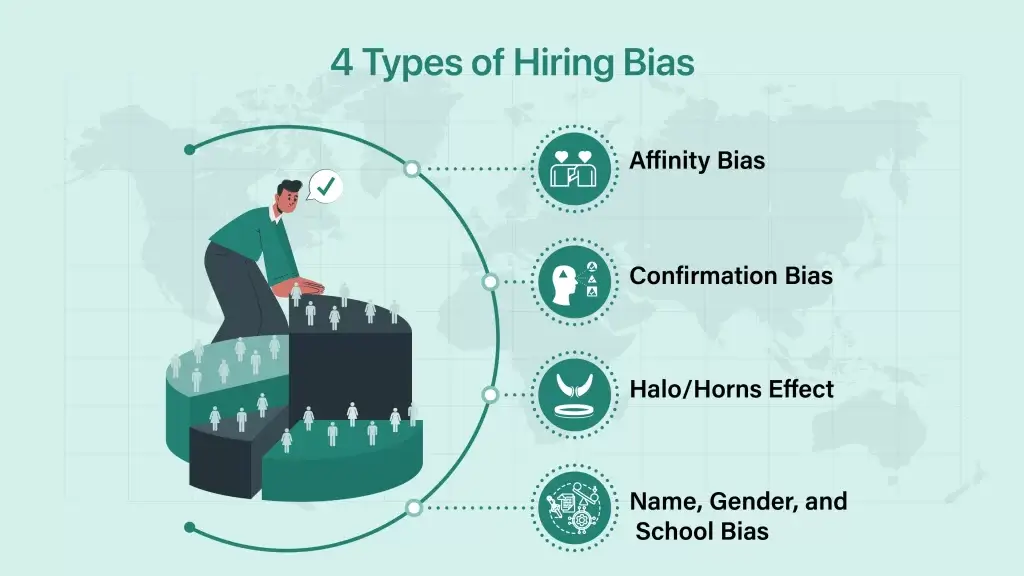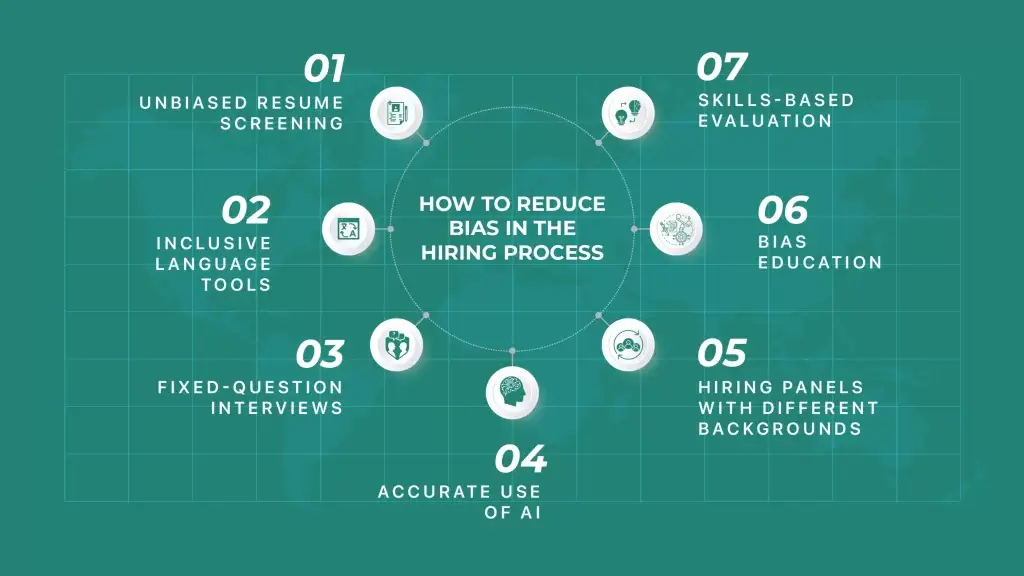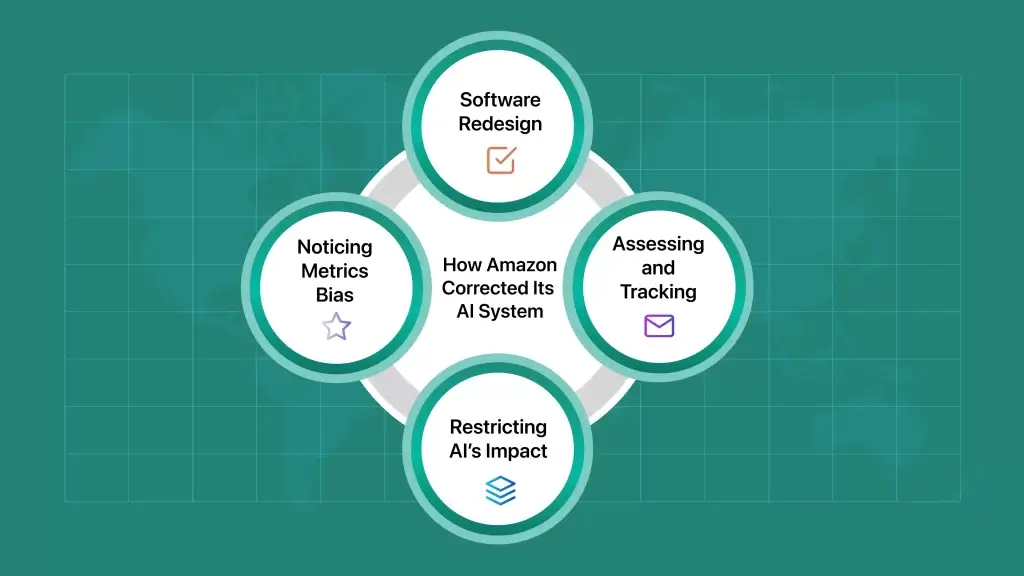
“50% of candidates, who felt biased during talking with HR managers, discontinue their application – A Gartner Finding”
Hiring bias is deeply rooted in the HR industry. Irrespective of its consequences, it has been practised for ages in almost every business. Knowingly or unknowingly, hiring bios can ignore top talent, damaging long-lasting retention.
Hiring bias results in more new hires failing, 16.1% more than an unbiased hire. It often costs organizations a lot of effort, time, and money, especially with less diverse teams.
Usually, hiring biases are so subtle that you never notice they influenced your hiring decision. Biased hiring overlooks good candidates, which attracts higher turnover and lower employee drive. Hiring bias also poorly depicts the company’s image in the job market, repelling top talent.
Unbiased hiring is not only fair—it’s the best policy for long-lasting success. It keeps employees engaged and motivated and elevates business operations.
This article explains how hiring bias enters your process, how to circumvent it by following predefined steps and updated HR technology, and why inclusive recruitment is the key to employee retention.
What Is Hiring Bias?
Hiring bias occurs when recruiters select or reject applicants based on their personal preferences, preset notions, or specific attributes. It may or may not be deliberate. Hiring bias is unfair, prevents diversity, and results in bad hiring choices.
Types of Hiring Bias

Different types of hiring bias can unfairly disadvantage candidates during the hiring process. Let’s examine these hiring biases more closely so companies can make more informed and healthy hiring decisions and build a diverse, strong, futuristic team.
1. Affinity Bias
This type of hiring bias occurs when the hiring manager unintentionally selects candidates from the same school, background, college, or place they belong. A LinkedIn report states – 42% of recruiters feel this type of bias is a top roadblock for creating a diverse work culture. This hiring bias can skew the perspective of diverse teams, and they overlook qualified individuals from different backgrounds.
2. Confirmation Bias
As the name suggests, confirmation bias occurs when an HR professional forms an opinion about a candidate and looks for data, preferences, and sources supporting that opinion, not considering anything else that disagrees. For example, if they believe the candidate is good at technology, they would ignore the red flags and focus only on looking for his technical nuances.
A report published in Proceedings of the National Academy of Sciences supports how confirmation bias impacts human brains.
3. Halo/Horns Effect
The Halo effect appears when a favorable attribute converts a candidate into the ideal choice. For example, an impressive resume or confidence impresses recruiters. This single trait ignores all other flaws. The horns effect tells a different story. It is the opposite. Like a casual approach, one bad trait forms an adverse impression, leading to unfair rejection.
As per CareerBuilder Survey 75% of employers admitted they made a bad hiring choice due to the Halo effect.
4. Name, Gender, and School Bias
Name hiring bias involves rating someone by name, usually disclosing their gender or background. “White-appearing” names are often more likely to get hired than others with the same skills. Gender bias involves hiring someone based on the abilities of a male or female. School bias is hiring someone merely because they graduate from an elite school.
Real-World Examples of Hiring Bias
- A company hires a candidate with a shared name, avoiding other qualified candidates (affinity bias)
- A person named “Christie” gets hired, whereas “Babita,” is rejected with similar qualifications (name bias).
- An IT company hires only from elite universities, ignoring talented candidates from other schools (school bias).
- A recruiter hires a male for an engineering position, rejecting a qualified female (gender bias).
Where to Find Hiring Bias in the Recruitment Funnel

No hiring stage is devoid of hiring bias. Let’s find out the stages where hiring bias infiltrates.
1. Job Descriptions
Hiring biased terms like “polite” or “softspoken” might appear to be the role for a specific gender. Specific cultural preferences can also make particular people feel persona non grata. This limits candidates, hurting the company’s reputation.
2. Resume Screening
- Recruiters often pick resumes with specific schools or employers, ditching other candidates.
- Often, ethnic-sounding names are ignored than familiar names.
- Often, alumni of elite institutes are more eligible, regardless of skill match.
3. Interviewing
While the interview process also involves hiring bias, it might affect the job offer during salary negotiations. Hiring candidates based on their last salary or negotiation expertise is evidence that gender or racial pay gaps exist.
As per a Gartner research, just 32% of workers are satisfied with their pay!
Impact of Hiring Bias – Kills Diversity, Creativity, and Retention
Hiring bias lowers diversity, hurts retention, and limits creativity. Diverse groups are more creative and inclusive. Therefore, it’s imperative to terminate hiring bias at every hiring funnel for the success of any business.
How Fair Hiring is a Win-Win
When hiring is fair, employees are loyal. They stay with the company longer and align their focus with the organisational vision.
1. Fairness Mobilizes Loyalty
Fairly hired and treated people rely on the company’s values, vision, and integrity. This brings job satisfaction and loyalty amongst the employees. Organizations with inclusive teams are more likely to be reputable and have a high employee retention rate.
2. People from Different Backgrounds Activate Better Collaboration
Diverse teams spark new ideas and promote interaction—candidates who feel welcomed and respected open up easily and speak freely. Inclusive businesses are more futuristic and have lower turnover rates.
3. Inclusive Hiring Sets the Stage
Inclusive hiring manifests equity in the company culture. This swarms and retains top brains from diverse backgrounds, forming a sustainable and productive team.
Eliminating hiring bias promotes retention, boosts innovation, and develops a strong, high-performing team.
7 Tested Ways to Remove Hiring Bias from Recruitment

To make hiring bias-free, you can follow these tips and tricks:
1. Unbiased Resume Screening
Clear names, images, and personal data from resumes.
Keep only skills and experience to judge fairly.
2. Inclusive Language Tools
Use software like Slackbots to find and delete biased words in job ads.
Bias-free ads welcome a wider, diverse group of applicants.
3. Fixed-question Interviews
Ask every aspirant the same questions.
Use scorecards for answers, not your feelings.
4. Accurate Use of AI
Use AI tools to assess resumes, but do not forget to check for fairness.
Feed AI with multiple data sources to deter repeating biases.
5. Hiring Panels with Different Backgrounds
Keep the interview panel diverse.
It is likely to select the right candidate.
6. Bias Education
Train the hiring team about unconscious bias.
Continuous training develops a decent hiring culture.
7. Skills-Based Evaluations
Check candidates on skills, not just resumes or interviews.
It forecasts job success better.
Combining the above practices builds a diverse and stronger workforce planning, deterring hiring bias.
Follow a Values-Based Hiring Practice
1. Switch from Cultural fit to Value-addition
A values-driven hiring system shifts the focus from finding people who “fit in” with those who add value to the company’s core vision.
In other words, you should look for people with unique ideas and diverse backgrounds. They are more likely to support the company’s primary objective and values.
2. Define Mission-based Traits
Create a list of critical values and traits your company focuses on, like integrity, teamwork, creativity, etc.
These traits align with your company’s primary objectives and visions. You should look for these attributes in the candidates to ensure new hires have the right qualities and align their goals with the company’s success.
3. Work Together to Develop Interview Structures
Welcome people from various sections to help build structured interview checklists. Hiring bias is reduced when different people work on a common goal, and the recruitment process aligns with the company’s values.
Using scorecards and real-life examples allows you to understand how aspirants have displayed their values on earlier occasions or how they respond in similar circumstances.
Results – Good Fit and Retention
- When companies hire candidates who share their attributes, employees are better and happier at work and rarely think of quitting.
- A study states that when employees and employers have the same shared value, turnover drops by up to 30%, and productivity goes up by 20–30%.
- Forbes says similar values improve job satisfaction, teamwork, and interaction.
- A survey by Robert Walters indicates 81% of managers think workers who fit well in the company do not leave so often, and 85% say they perform better.
- Shifting from cultural fit to value addition enables companies to create more creative, strong, inclusive, and loyal teams, which results in long-term success for the company.
Link Hiring Practices to Employee Retention
Feedback on every decision improves future decision-making. To overcome hiring bias, building a feedback funnel between hiring and retention can improve companies’ hiring choices and retention rates.
Businesses can analyze what works well by connecting information gathered during hiring-like processes and values with their performance and stay after joining.
This ongoing practice helps HR executives track feedback from new employees, trigger red flags early, and redesign the hiring or onboarding process to support the workers.
Here are the ways to avoid hiring bias, creating a feedback chain between hiring and retention:
Monitor Retention Rates by Hiring Source or Process Stage
- Begin to track how long workers stay and how frequently they quit.
- Further, this data can be narrowed down by where they came from (e.g., place of job origin) and every stage in the hiring process.
- This will help you assess what channels and ways bring candidates who stay longer and perform well.
- Using software that automates this tracking makes it easier for HR people to determine what works and what does not.
Conduct Stay and Exit Interviews
Stay interviews are proactive conversations with current employees to understand what keeps them engaged and what might prompt them to leave.
- Interactions with current employees about their jobs and the red flags that might prompt them to quit are a great way to understand their feedback on the job and the reasons for quitting.
- It helps companies to understand what makes employees stay and what needs to be improved.
Exit interviews collect feedback from workers who are leaving. They provide opinions of departing workers about the causes of quitting and turnover.
- Regularly conducting both types of interviews helps you understand the employee experience at different stages.
- The data you gather is vital in improving the workplace polices for future employees.
Take Action on Feedback to Avoid Hiring Bias
- Use constructive feedback from retention input, stay, and exit interviews to improve your hiring funnel and ditch hiring bias.
- On realizing that people from a specific job board leave frequently, rework your recruitment efforts to find better sources.
- On understanding from stay interviews that some traits are critical, rewrite your job descriptions and interview questions to pick candidates with these attributes to hire.
- Read the feedback and hiring matrix to understand what works and what doesn’t.
- This consistent feedback channel helps you bring on board people who are more likely to stay, making your hiring and retention strategies work better together and avoiding hiring bias.
Case Study

Amazon built an AI hiring tool to fast-track the hiring process, which ended up avoiding female applicants and supporting male applicants. This case is a true testimony of the glitches of using AI in recruitment and how to address these issues.
How Amazon Corrected Its AI System
- Software Redesign:
Amazon reprogrammed the tool to neutralize gender-specific terms. - Assessing and Tracking:
They regularly monitor the tool to identify and address issues and track its outputs to identify other hiring biases. - Restricting AI’s Impact:
They never used AI tools’ recommendations as the only decision-maker when hiring. Absolute human control reduced hiring biases. - Noticing Metrics Bias:
Amazon learned that the training data was the basic cause of hiring bias, highlighting male dominance in the IT sector. They fed AI with more polished and diverse data for fair hiring.
Avoiding Hiring Bias: Lessons and Suggested Solutions
- Keep an eye on AI algorithms for hiring bias.
- Deploy diverse training feeds to balance the AI data against gender bias.
- Include human intelligence also in automated hiring processes.
- Track and refine algorithms to avoid any emerging hiring biases.
This case study suggests AI can speed up hiring, but it needs systematic and regular vigilance, various data, and human prudence to mitigate hiring bias.
Conclusion
Avoiding hiring bias is not only the right way to employ people; it’s also a smart business strategy that prompts employee retention. Companies with fair and inclusive hiring rules create a reliable and robust team.
By linking hiring decisions with retention algorithms and employee feedback, companies can continually nudge their processes for long-lasting success.
Quick Action Tips:
- Assess a job post for biased language and make it bias-free to attract more applicants.
- Use scorecards in your future interviews to ensure fair evaluation of all applicants.
- Study turnover percentage by role or department to find trends and address red flags early.
These easy steps result in a fair hiring process and help create a strong and effective workforce.
Ready to take the next step?
Find out key features of our products, read our blog on how AI can be used in recruitment, or book a free consultation/demo to see how you can build a better hiring process today!
FAQ
1. What is the common yet overlooked hiring bias?
The most common form of hiring bias is affinity bias, which favours candidates with traits similar to the recruiter.
2. What are other types of hiring biases?
Name bias, gender bias, school bias, and confirmation bias are other forms of biases.
3. How can AI reduce hiring bias?
AI can deter hiring bias by masking resumes and unifying evaluations, with a regular audit.
4. How can companies curb unconscious bias?
Use masked screening, defined interviews, diverse panels, unbiased inputs to AI, and regular review of hiring data.
Hiring Checklist for Recruiters
- Evaluate job ads for biased terms.
- Use blind resume screening.
- Apply structured interviews with scorecards.
- Include multiple interview panels.
- Educate hiring members about bias.
- Track hiring and retention algorithm by demographics.
- Take feedback for better hiring.
About us
ValueMatrix helps organizations build culturally cohesive teams with AI-powered recruitment and retention strategies. We educate corporate leaders on the need to involve and encourage all generations to adapt to enterprise values and participate actively to gain excellence.
Our AI-powered platform transforms talent acquisition with intelligent hiring techniques backed by established psychological frameworks. We partner with HR professionals to conduct unbiased and holistic assessments for aspiring candidates.




